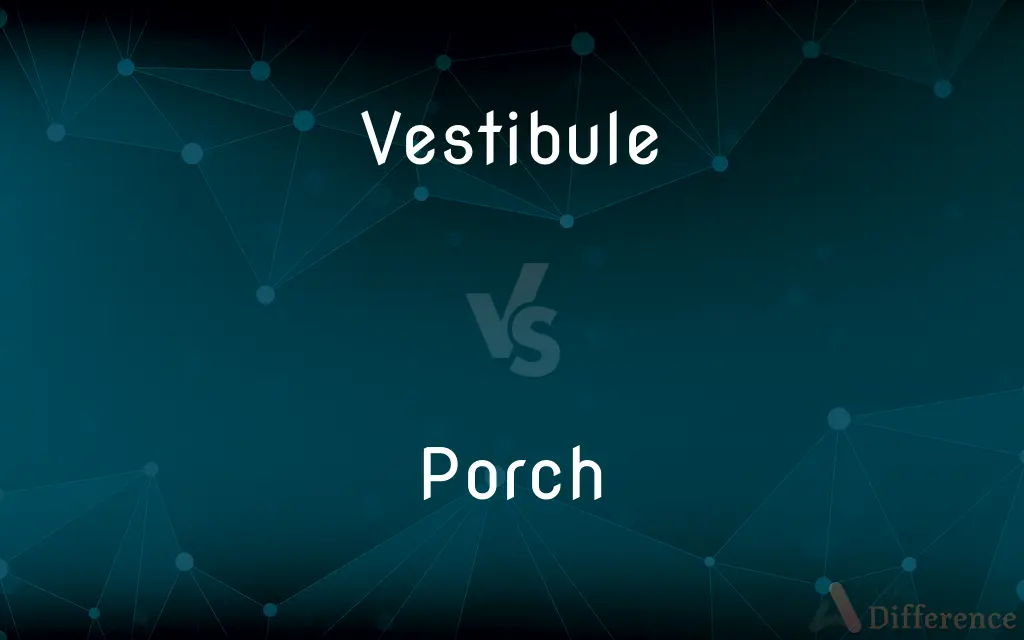Vestibule vs. Porch — What's the Difference?
By Urooj Arif & Maham Liaqat — Updated on March 8, 2024
A vestibule is a small enclosed entryway inside a building, while a porch is an external structure attached to the entrance of a building, often open or partially enclosed.

Difference Between Vestibule and Porch
Table of Contents
ADVERTISEMENT
Key Differences
Vestibules serve as transitional spaces between the exterior and the main interior of a building, providing a buffer zone that can help in controlling temperature, noise, and privacy. They are typically found just inside the main entrance and can be used for various purposes, including as a waiting area, to store outdoor clothing, or to provide an additional layer of security. In contrast, porches are external structures that extend from the outer wall of a building, often covering the entrance or wrapping around the exterior.
While vestibules are primarily functional, offering protection from the elements and acting as an airlock to conserve energy, porches often add aesthetic value to a building, enhancing its architectural style and providing a welcoming entrance.
The choice between adding a vestibule or a porch to a building depends on the intended use, climate considerations, and architectural preferences. Porches can be open, partially enclosed, or screened, and are designed to provide a covered outdoor space for activities such as sitting, socializing, or enjoying the view.
While vestibules are primarily functional, offering protection from the elements and acting as an airlock to conserve energy, porches often add aesthetic value to a building, enhancing its architectural style and providing a welcoming entrance. The choice between adding a vestibule or a porch to a building depends on the intended use, climate considerations, and architectural preferences.
Both vestibules and porches can contribute to the thermal efficiency of a building, with vestibules trapping air to minimize heat loss and porches providing shade and reducing direct sunlight. However, their designs and placements reflect their distinct purposes, with vestibules focusing on the interior experience and porches emphasizing the transition between indoor and outdoor spaces.
ADVERTISEMENT
Comparison Chart
Location
Inside the building, just beyond the main entrance.
External structure attached to the entrance of a building.
Function
Acts as a buffer zone for temperature, noise, and privacy.
Provides a covered outdoor space for various activities.
Enclosure
Enclosed entryway.
Can be open, partially enclosed, or screened.
Purpose
Controls temperature, conserves energy, provides security.
Enhances aesthetic appeal, offers outdoor seating, protects from elements.
Architectural Focus
Interior experience and functionality.
Transition between indoor and outdoor spaces, architectural style.
Compare with Definitions
Vestibule
Can be used for various purposes like storage or waiting areas.
The museum's vestibule had benches and lockers for visitors to store their belongings.
Porch
An external structure attached to the entrance of a building.
The Victorian home featured a spacious wrap-around porch adorned with decorative railings.
Vestibule
A small enclosed entryway inside a building.
The office building's vestibule prevented cold air from entering the main lobby during the winter.
Porch
Designed for activities like sitting, socializing, or enjoying the view.
The porch had rocking chairs and a small table for morning coffee and newspaper reading.
Vestibule
May provide an additional layer of security or privacy.
The vestibule featured a secure entry system to control access to the building's residential floors.
Porch
Adds aesthetic value and enhances the architectural style of a building.
The craftsman-style house was distinguished by its large, inviting front porch with wooden columns.
Vestibule
Serves as a transitional space between the outside and the interior.
Guests were welcomed in the vestibule before being guided to the reception area.
Porch
Often open or partially enclosed, providing a covered outdoor space.
The family enjoyed summer evenings on their screened porch, free from mosquitoes.
Vestibule
Helps in controlling indoor climate and conserving energy.
Adding a vestibule to the entrance helped reduce the heating costs for the apartment complex.
Porch
Protects the entrance from the elements and offers a welcoming entrance.
The covered porch shielded visitors from rain as they rang the doorbell, adding to the home's curb appeal.
Vestibule
A small entrance hall or passage between the outer door and the interior of a house or building.
Porch
A porch (from Old French porche, from Latin porticus "colonnade", from porta "passage") is a room or gallery located in front of an entrance of a building. A porch is placed in front of the facade of a building it commands, and forms a low front.
Vestibule
An enclosed area at the end of a passenger car on a railroad train.
Porch
A covered platform, usually having a separate roof, at an entrance to a building.
Vestibule
(Anatomy) A body cavity, chamber, or channel that leads to or is an entrance to another body cavity
The vestibule of the inner ear.
Porch
An open or enclosed gallery or room attached to the outside of a building; a veranda.
Vestibule
(architecture) A small entrance hall, antechamber, passage, or room between the outer door and the main hall, lobby, or interior of a building.
Porch
(Obsolete) A portico or covered walk.
Vestibule
(architecture) A large entrance hall in a temple or palace.
Porch
(architectural element) A covered entrance to a building, whether taken from the interior, and forming a sort of vestibule within the main wall, or projecting without and with a separate roof. A porch often has chair(s), table(s) and swings.
Vestibule
(rail transport) An enclosed entrance at the end of a railway passenger car.
Porch
A portico; a covered walk.
Vestibule
(anatomy) Any of a number of body cavities or channels, serving as or resembling an entrance to another bodily space.
Porch
The platform outside the external hatch of a spacecraft.
Vestibule
The central cavity of the bony labyrinth of the inner ear or the parts (such as the saccule and utricle) of the membranous labyrinth that it contains.
Porch
A covered and inclosed entrance to a building, whether taken from the interior, and forming a sort of vestibule within the main wall, or projecting without and with a separate roof. Sometimes the porch is large enough to serve as a covered walk. See also Carriage porch, under Carriage, and Loggia.
The graceless Helen in the porch I spiedOf Vesta's temple.
Vestibule
The part of the left ventricle below the aortic orifice.
Porch
A portico; a covered walk.
Repair to Pompey's porch, where you shall find find us.
Vestibule
The part of the mouth outside the teeth and gums.
Porch
A structure attached to the exterior of a building often forming a covered entrance
Vestibule
Clip of vulval vestibule: the space in the vulva between the labia minora and into which both the urethra and vagina open.
Vestibule
(transitive) To furnish with a vestibule or vestibules.
Vestibule
The porch or entrance into a house; a hall or antechamber next the entrance; a lobby; a porch; a hall.
Vestibule
To furnish with a vestibule or vestibules.
Vestibule
A large entrance or reception room or area
Vestibule
Any of various bodily cavities leading to another cavity (as of the ear or vagina)
Common Curiosities
Can a building have both a vestibule and a porch?
Yes, some buildings may feature both, with the porch serving as an external covered area and the vestibule providing an enclosed transitional space inside.
How do vestibules contribute to energy efficiency?
Vestibules act as airlocks, preventing cold air from entering in the winter and hot air in the summer, thereby reducing heating and cooling costs.
Can porches be used year-round?
Depending on the climate and whether the porch is open, enclosed, or screened, porches can be designed for year-round use with the addition of features like heaters or fans.
How can porches enhance the curb appeal of a home?
Porches can add visual interest and character to a home's facade, making it more inviting and increasing its perceived value.
Are there regulations governing the construction of vestibules or porches?
Building codes and local regulations may dictate specifications for vestibules and porches, including size, materials, and safety features.
What types of buildings commonly have vestibules?
Vestibules are common in commercial buildings, high-rise apartments, and public buildings where controlling indoor climate and security is important.
Is a vestibule considered part of the building's interior or exterior?
A vestibule is considered part of the interior, as it is enclosed and located just beyond the main entrance inside the building.
What are common materials used for porch construction?
Porches can be made from a variety of materials, including wood, composite, brick, and stone, depending on the desired aesthetic and structural requirements.
How do vestibules and porches impact the flow of natural light into a building?
Vestibules might limit direct natural light entry, depending on their design, while porches can provide shaded natural light to adjacent indoor spaces.
How do modern vestibules differ from traditional ones?
Modern vestibules often incorporate contemporary design elements, advanced materials, and may include features like automatic doors and smart security systems.
How do seasonal changes affect the use and functionality of porches and vestibules?
Seasonal changes can impact usage, with porches being more popular in warmer months and vestibules providing year-round benefits by buffering against adverse weather conditions.
Can vestibules and porches be added to an existing building?
Yes, both can be added to existing structures, but this may require renovation work and adherence to building codes and regulations.
How do cultural or regional differences influence the design of porches and vestibules?
Design preferences for porches and vestibules can vary widely based on cultural and regional influences, reflecting local architectural styles, climate considerations, and lifestyle needs.
What maintenance considerations exist for vestibules and porches?
Maintenance for vestibules may involve cleaning, door adjustments, and climate control systems, while porch maintenance can include care for decking, railings, and any outdoor furniture.
What safety features can be integrated into the design of porches and vestibules?
Safety features can include non-slip flooring, adequate lighting, handrails, and secure locks for vestibules.
Share Your Discovery

Previous Comparison
Multimer vs. Polymer
Next Comparison
Spirituality vs. PhilosophyAuthor Spotlight
Written by
Urooj ArifUrooj is a skilled content writer at Ask Difference, known for her exceptional ability to simplify complex topics into engaging and informative content. With a passion for research and a flair for clear, concise writing, she consistently delivers articles that resonate with our diverse audience.
Co-written by
Maham Liaqat













































